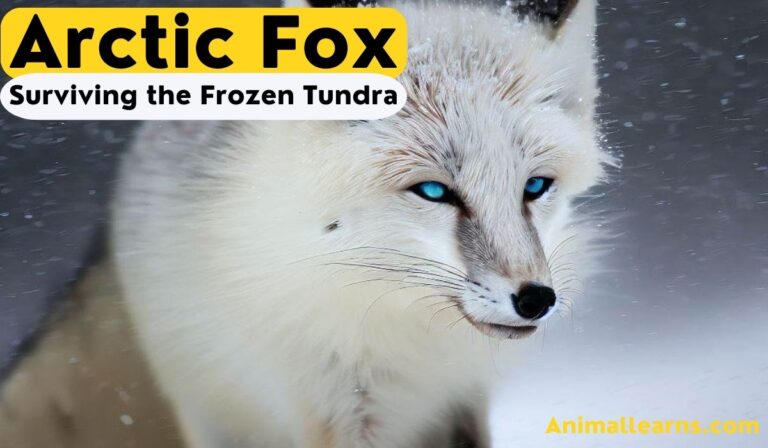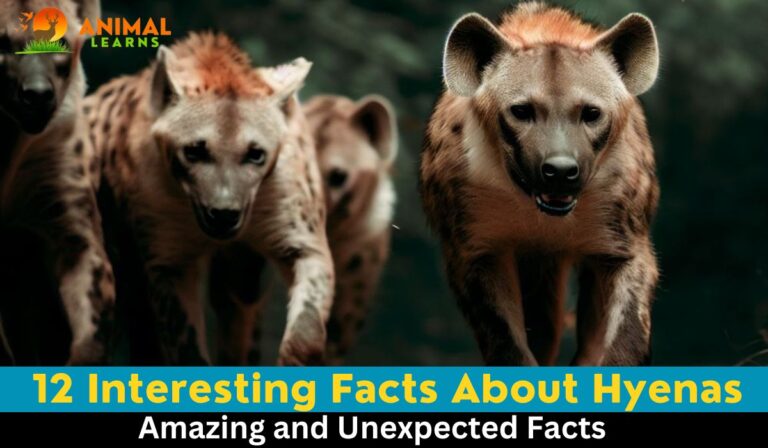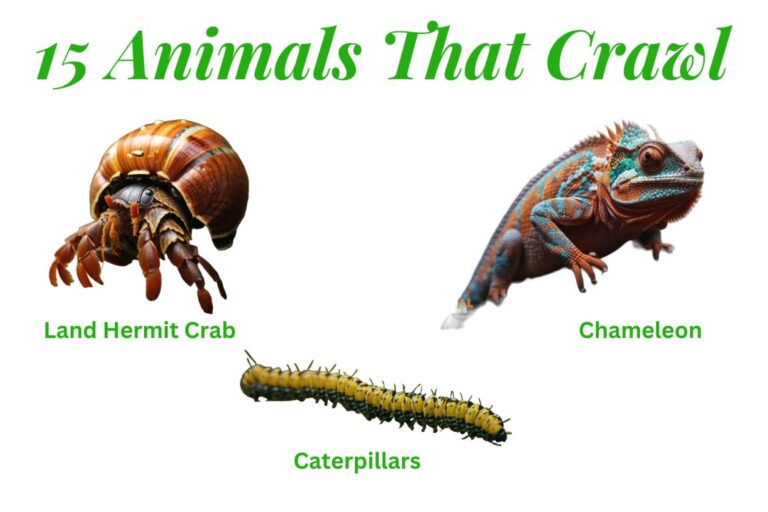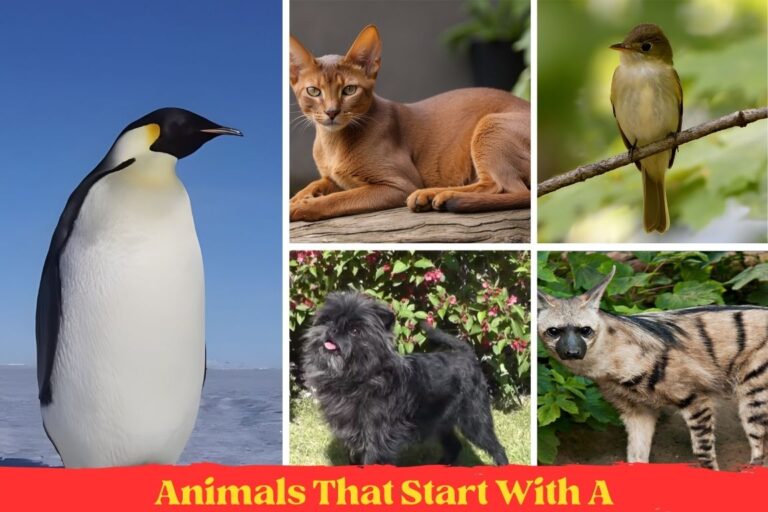Burchell’s Zebras: The Symbol of African Wilderness

| Attribute | Information |
| Scientific Name | Equus zebra burchellii |
| Common Name | Burchell’s Zebra |
| Habitat | Southern African Grasslands and Savannas |
| Location | South Africa, Namibia, Botswana, Zimbabwe |
| Diet | Herbivorous (Primarily Grazing on Grasses) |
| Average Lifespan | 20 to 30 years |
| Size | Height: 4.6 to 5.6 feet (at the shoulder) |
| Weight | 770 to 990 pounds (350 to 450 kg) |
| Distinctive Feature | Black and White Striped Coat |
| Social Behavior | Highly Social, Forming Herds |
| Predators | Lions, Hyenas, African Wild Dogs, Crocodiles |
| Conservation Status | Least Concern |
| Notable Fact | Each Zebra Has a Unique Stripe Pattern |
Burchell’s zebras are more than just beautiful and iconic animals. They are also a symbol of Africa’s rich and diverse wildlife. They show us how nature can create amazing patterns and adaptations. They inspire us to appreciate and respect the natural world.
Burchell’s zebras are not just any ordinary zebras. They have stunning black and white stripes that make them stand out from the crowd. No two zebras have the same stripes. They are like fingerprints, unique to each individual.
Burchell’s zebras are very important for the African savanna ecosystem. They help keep the grasses healthy and prevent them from overgrowing. They also provide food for other animals, such as lions, hyenas, and cheetahs. But don’t worry, these zebras have a clever way of avoiding being eaten.
Their stripes act as camouflage, making it hard for predators to spot them or single them out from the herd.
Burchell’s Zebra appearance
Contents
- 1 Burchell’s Zebra appearance
- 2 Diet
- 3 Characteristics
- 4 Habitat and Distribution
- 5 Behavior and Lifestyle
- 6 Burchell’s Zebras: Types and Subspecies
- 7 Burchell’s Zebras: Amazing Facts
- 8 Predators
- 9 Mountain Zebras vs. Burchell’s Zebras: A Comparative Overview
- 10 Challenges faced
- 11 Burchell’s Zebra Migration
- 12 Burchell’s Zebra: Conservation and Ecological Insights
- 13 FAQs
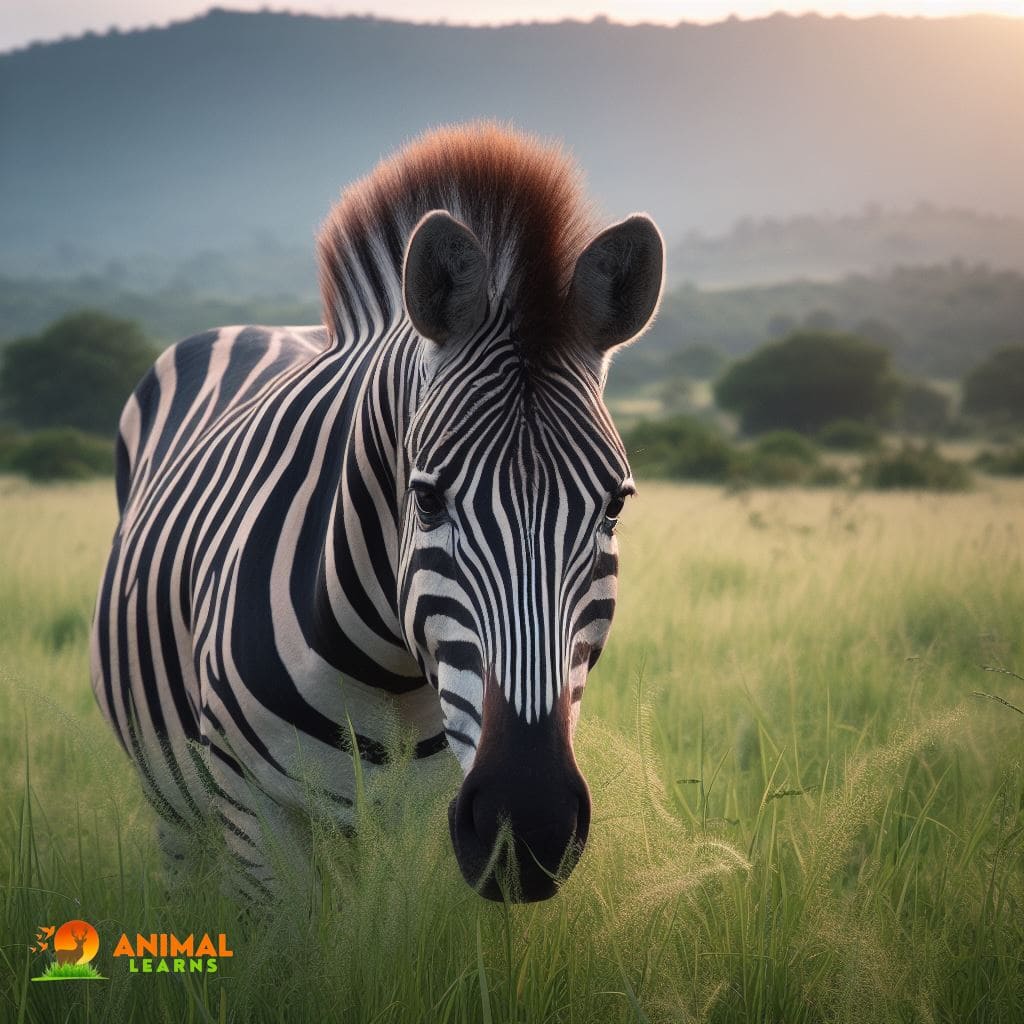
Burchell’s zebras are famous for their stunning black and white stripes. No two zebras have the same pattern, just like human fingerprints. They have a black nose, fluffy ears, and a hairy tail.
They are fast and agile, with slim legs and sharp hooves. Their amazing stripes help them hide from predators and blend into the grassy savanna. Burchell’s zebras are truly unique and beautiful animals.
Diet
Burchell’s zebras love to munch on grasses. They have a special stomach that can digest the tough plants they find in the savanna and grassland. They have strong teeth and flexible lips that help them cut and pick the best parts of the grass. They are always looking for new places to graze.
Characteristics
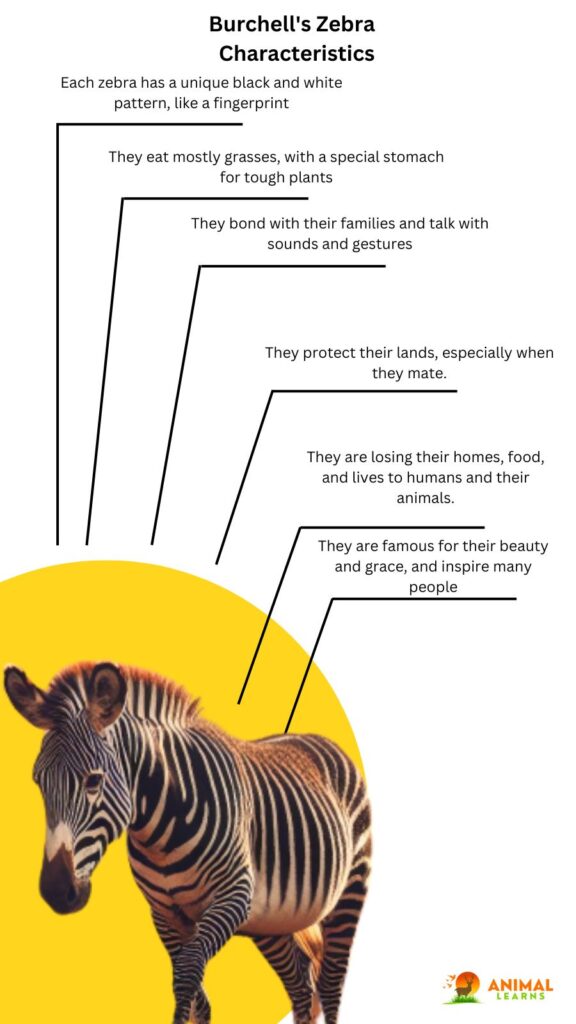
- Stripes: Each zebra has a unique black-and-white pattern, like a fingerprint.
- Diet: They eat mostly grasses, with a special stomach for tough plants.
- Social: They bond with their families and talk with sounds and gestures.
- Territorial: They protect their lands, especially when they mate.
- Alert: They are always on the lookout for danger and run fast.
- Water: They need to drink from nearby sources every day.
- Camouflage: Their stripes make them hard to spot in groups by predators.
- Birth: They have one baby at a time, after a year of pregnancy. The baby can walk soon after birth.
- Threats: They are losing their homes, food, and lives to humans and their animals.
- Symbol: They are famous for their beauty and grace, and inspire many people.
Habitat and Distribution
Burchell’s zebras are not just any ordinary horses. They are the striped horses that live in the diverse landscapes of southern Africa. You can find them in countries like South Africa, Namibia, Botswana, and Zimbabwe.
They are very adaptable and can live in different ecosystems, such as savannas, grasslands, and woodlands. But they love water more than anything else. They need water to survive because they are water-dependent animals. They eat plants that grow near water sources, such as rivers or watering holes.
They never go too far from these water sources, usually less than 12 kilometers. This shows how well they have adapted to their environment and how they balance their needs with the resources available.
Behavior and Lifestyle
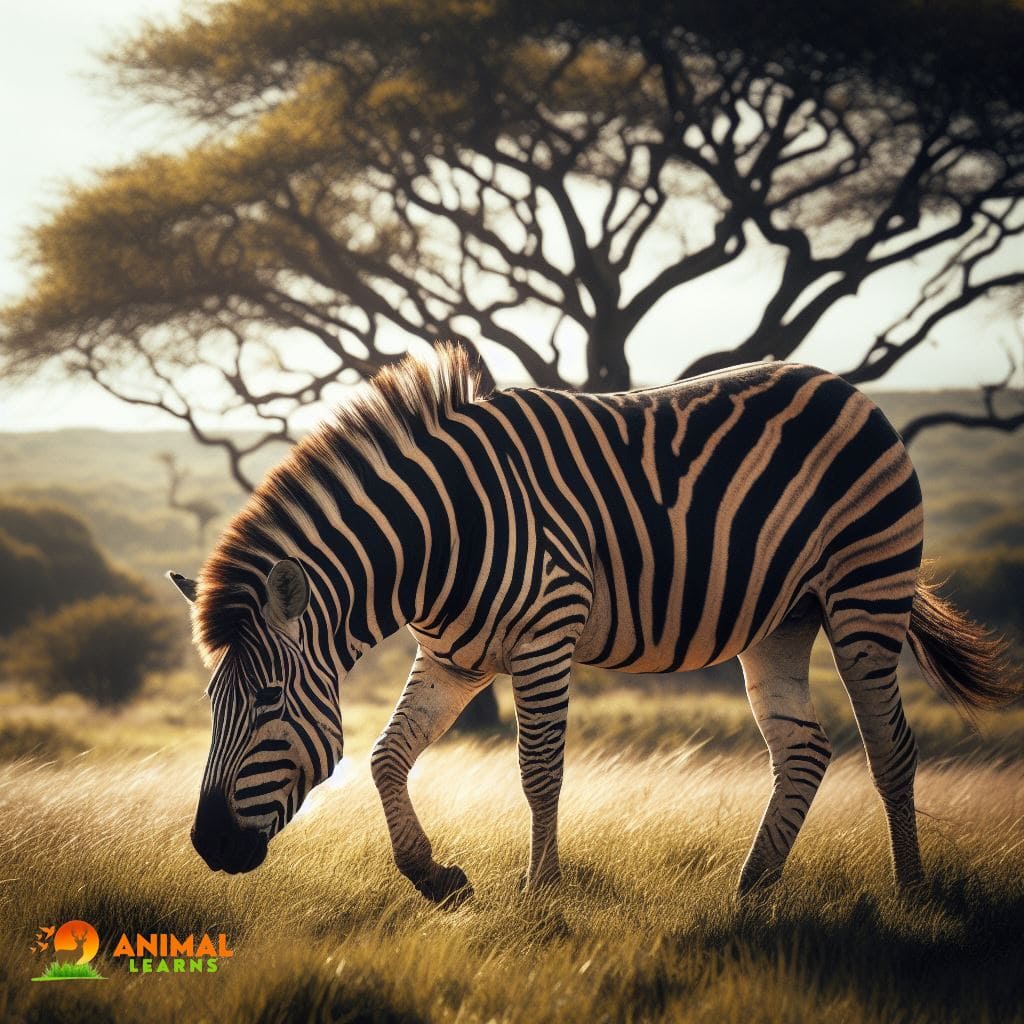
Burchell’s zebras are not just beautiful animals with striking black and white stripes. They are also fascinating creatures with complex social behavior and a unique lifestyle in the African savanna. They love to be around other zebras, forming herds of different sizes, from cozy family groups to large gatherings.
They have strong bonds with their relatives, especially between mothers and their babies. They communicate with each other using sounds like braying and whinnying, as well as gestures like grooming and mutual grooming, to create friendships and keep peace in the herd.
They are always alert and watchful, as they have to deal with dangerous predators like lions and hyenas. Burchell’s zebras are fast and agile and can run away from trouble at amazing speeds, using their quick reactions to dodge attacks.
They spend most of their time looking for food, moving from one place to another in search of fresh grass, making them an important part of the ever-changing ecosystems they live in.
Burchell’s Zebras: Types and Subspecies
Burchell’s zebras are a kind of zebra with different variations and subspecies. They all have black and white stripes, but some have different patterns and colors.
Southern Burchell’s Zebra
This is the most common and well-known type of Burchell’s zebra. They live in countries like South Africa, Namibia, Botswana, and Zimbabwe. Their stripes are bold and beautiful, and no two zebras have the same pattern.
Crawshay’s Zebra
This is a subspecies of Burchell’s zebra with brighter and thicker stripes. They live mainly in the Luangwa Valley of Zambia. Their stripes stand out more than other Burchell’s zebras.
Damara Zebra
This is another subspecies of Burchell’s zebra that lives mostly in Namibia. They have a stocky body and a complex stripe pattern. They can survive in dry and hot areas.
Feral Burchell’s Zebra
Some of Burchell’s zebras have escaped or been released into new places. They have changed their coat color and stripe pattern to fit in. They can live in many different environments, even outside Africa.
Burchell’s zebras are amazing animals with different types and subspecies. Each one has its own unique stripe pattern and coat characteristics. They all have the same stunning look that makes them a part of the African savanna.
Burchell’s Zebras: Amazing Facts
- Unique Stripes: Each zebra has a different stripe pattern, like a fingerprint. No two zebras are exactly alike.
- Camouflage and Protection: The stripes help zebras blend in and trick predators. They look like one big animal when they are together.
- Cultural Icon: Zebras are symbols of Africa and its beauty. They are often seen in movies, pictures, and art.
- Precocial Foals: Zebra babies can stand and walk right after they are born. They can join the herd and avoid danger quickly.
- Vocal Communicators: Zebras make different sounds to talk to each other and warn of threats. They can bray, whinny, snort, and more.
- Strong Family Bonds: Zebras stick together in families within their herds. Mothers and babies have a special bond and stay close.
- Agile Escapes: Zebras are fast and nimble when they run from predators. They can reach speeds of up to 65 km/h (40 mph).
- Water Dependency: Zebras need water every day to survive. They can travel up to 12 km (7.5 miles) to find water sources.
- Stripes in the Sun: The black stripes may help zebras cool down and control their body temperature. They absorb more heat than the white stripes.
- Fossil Relatives: Zebras have ancient ancestors that lived thousands of years ago. Their fossils tell us about their evolution and history.
Predators

Living in the African savanna is not easy for Burchell’s zebras. They have to deal with many dangerous predators that want to make a meal out of them. Some of the most fearsome ones are lions, spotted hyenas, and African wild dogs.
Lions are master hunters who work together to catch zebras, especially the young or weak ones. Spotted hyenas are always on the lookout for a chance to snatch a zebra, whether by hunting or scavenging. African wild dogs may not be as common, but they are very good at hunting in packs and can chase down zebras, especially the little ones.
And if that’s not enough, zebras also have to watch out for crocodiles when they cross rivers to drink water. But Burchell’s zebras are not helpless. They have developed some smart ways to protect themselves and escape from their enemies.
Mountain Zebras vs. Burchell’s Zebras: A Comparative Overview
Comparing Mountain zebras to Burchell’s zebras provides valuable insights into the diversity of the Equus genus. Burchell’s zebras, classified as Equus zebra zebra, enjoy a relatively stable population in their African habitats and are not considered endangered or extinct.
In contrast, Mountain zebras, scientifically known as Equus zebra, face greater conservation challenges, with two of their subspecies classified as endangered. While Burchell’s zebras favor the savannahs and grasslands, Mountain zebras thrive in more rugged, mountainous terrain.
Additionally, Burchell’s zebras are known for their seasonal migrations, which are essential for survival, whereas Mountain zebras tend to exhibit more sedentary behavior. Understanding these distinctions sheds light on the unique ecological roles of these two zebra species and underscores the importance of conservation efforts to protect their populations and habitats.
Top of Form
Challenges faced
Burchell’s zebras have a tough life in the wild. They have to deal with many problems that humans cause, such as taking over their land for farming and building, which leaves them with less space to roam and graze. They also have to compete with cows and sheep for water and food, which are scarce and precious.
On top of that, some people hunt them for their meat and skin, even though they are protected by law. And if that’s not enough, they also have to cope with the changing climate, which affects how much water and plants they can find. But Burchell’s zebras are not giving up.
They have some friends who are trying to save them and their habitat. These are the conservationists who work hard to make sure that these beautiful zebras can survive and thrive for many years to come.
Burchell’s Zebra Migration

Why do Burchell’s zebras travel so far? It’s because they are looking for food and water, which can be hard to find in Africa. Sometimes, they have to leave their home and go to another place where there is more grass and water. They do this every year when the dry season comes and their home becomes dry and barren.
Burchell’s zebras are amazing travelers. They can walk for hundreds of kilometers, crossing different landscapes and rivers. They are not alone in their journey. They travel with other zebras and animals, forming a huge group of moving wildlife. It’s a sight to behold!
But their migration is not just for fun. It’s a matter of life and death. They have to find enough food and water to survive and feed their young. They also have to avoid predators and other dangers along the way. Their migration depends on many factors, such as the weather, the availability of resources, and the season.
Burchell’s Zebra: Conservation and Ecological Insights
Burchell’s zebra (Equus zebra zebra) is a captivating species that holds a prominent role in African ecosystems. Unlike some other zebra species, Burchell’s zebras are not extinct and are not currently considered endangered. Their population can still be found in various regions of Africa, reflecting the importance of their presence in the wild.
These zebras play a crucial role in their ecosystem as herbivores, helping control vegetation growth through their selective diet of grasses. Moreover, their extensive migrations, driven by the need for food and water, contribute to the dispersion of plant seeds and nutrient cycling in their habitat.
Despite their value in the ecosystem, it’s essential to recognize that Burchell’s zebras can be dangerous, particularly when provoked. Their powerful kicks and bites serve as a defense mechanism against potential threats, highlighting the need for caution when encountering them in the wild.
FAQs
What are the characteristics of the Burchell’s zebra?
These zebras are known for their black and white stripes, social behavior, herbivorous diet, and presence in southern African grasslands.
What is the difference between Burchell’s zebra and plains zebra?
Burchell’s zebras are a type of plains zebra found in southern Africa, while “plains zebra” encompasses multiple subspecies across Africa.
What are some interesting facts about Burchell’s zebra?
They have unique stripe patterns like fingerprints, serving as natural protection. They’re water-dependent and iconic symbols of Africa.
What is the Burchell’s zebra diet?
They’re herbivores primarily grazing on grasses, with specialized digestion.
What are zebras famous for?
Striking black and white stripes, strong social behavior, and symbolizing African wildlife.
What is the meaning of Burchell’s zebra?
Named after explorer William John Burchell, who contributed to African wildlife research.








